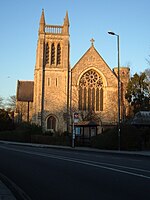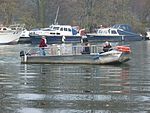Chapel House, Twickenham
1720s establishments in EnglandAlfred, Lord TennysonGrade II* listed buildings in the London Borough of Richmond upon ThamesGrade II* listed houses in LondonHistory of the London Borough of Richmond upon Thames ... and 5 more
Houses in the London Borough of Richmond upon ThamesPete TownshendTourist attractions in the London Borough of Richmond upon ThamesTwickenhamUse British English from July 2020

Chapel House, now No. 15, Montpelier Row, Twickenham, is a house in Greater London, England. The house has also been called Tennyson House and Holyrood House. It was occupied at one time by Alfred Tennyson, and poet Walter de la Mare lived in the same row nearly a hundred years later. The house was owned for many years by musician Pete Townshend, principal songwriter of The Who.
Excerpt from the Wikipedia article Chapel House, Twickenham (License: CC BY-SA 3.0, Authors, Images).Chapel House, Twickenham
Chapel Road, London St Margarets (London Borough of Richmond upon Thames)
Geographical coordinates (GPS) Address Nearby Places Show on map
Geographical coordinates (GPS)
| Latitude | Longitude |
|---|---|
| N 51.450631 ° | E -0.317402 ° |
Address
Chapel Road
Chapel Road
TW1 2NQ London, St Margarets (London Borough of Richmond upon Thames)
England, United Kingdom
Open on Google Maps









